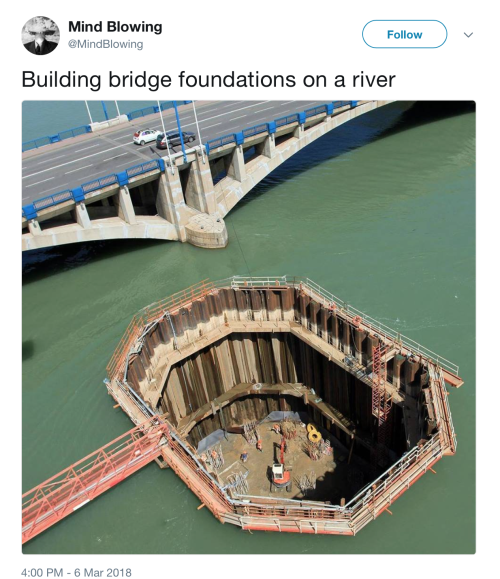lizziegoneastray:vintagebutterfly:postmodernmulticoloredcloak:awed-frog:somethingdnd:brunhiddensmusi
lizziegoneastray:vintagebutterfly:postmodernmulticoloredcloak:awed-frog:somethingdnd:brunhiddensmusings:pochowek:pondwitch:tyloriousrex:chrissongzzz:So how do they make that?This just raises more questions for me ♂️what the FUCKthis is whats called a ‘coffer dam’, you basically build some walls, drop them in the water, tie them together, and then pump out the water from your new hole in the water so you can build while staying dryits oddly not that hard- the flippin ROMANS were able to do it with logs and mudoccasionally particularly devious people would use this to hide treasure or tombs underneath the river so its not only impossible to find but impossible to get to without an engineer divisionthat last part gives me ideas for campaigns“Not that hard - the ROMANS were able to do it” - people seriously underestimate how advanced some ancient cultures were and the organized effort it takes to come up with something like this and actually implement it. The Romans had heated floors, glass windows and ceilings that could be rotated to reflect what you were eating (forests for game, sea landscapes for fish). Hell, the Greeks built cameras and moving robots. The Minoans, who lived four thousands years ago and were wiped out by a tsunami three times as powerful as the one which devasted Japan in 2011, had running water and modern toilets. And let’s not get into how China basically invented everything centuries before anyone else. Bottom line: just because someone was already doing it thousands of years ago, doesn’t mean it’s not very difficult and an extraordinary feat of engineering.someone: you build how many bridges on a single military campaign…?Caesar: what, like it’s hard?The Indus valley civilisations (one of the cradles of civilisation) had a covered sewer system. The first urban sanitation system might have been Harappa around 4 500 years ago. It included baths. The people in Lothal had a toilet in every house around 4370 years ago. They also had normed brick sizes to make building easier.While we’re on industrial norms: Mesopotamia (another cradle of civilisation) had mass-produced bowls. They were traded with other city-states (read: internationally). They also had a writing system, schools (at least for the upper class), and exercise slates. The Sumerians and Akkadians in Mesopotamia formed a sprachbund that meant many people were bilingual in the 3rd millennium BC. While we’re on the topic of literacy in ancient civilisations: Signboards were a thing. Enough people were literate to have signboards and inscriptions on houses. The oldest known inscription is on a lintel in Dholavira, Indus valley from 5000ish years ago (We have no idea what it says though.).That’s just my five cents to people have always been people, and people have always been awesome. Sorry for the rant (but do tell me if you want to hear more about awesome in the other cradles of civilisation; or the proto-communism debate; or the “mother-goddess” debacle; or egalitarian values in ancient cultures (I might have to re-read Plato to go into full detail on that one and include the Greeks).Please never apologize for adding cool info to posts! And feel free to add more :) -- source link

